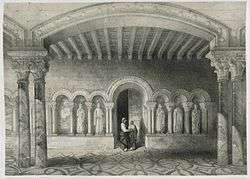Monastery of Benevívere
The Monastery of Benevívere (Spanish: Abadía de Santa María de Benevívere) was an Abbey in Spain, famous in the twelfth century. It is now ruined. It is about 4.8 kilometres (3.0 mi) west of Carrión de los Condes in the Province of Palencia.[1]
 Dans le Monastère de Bénévivere by Jean Charles Léon Danjoy (1841) | |
 Location within Spain | |
| Monastery information | |
|---|---|
| Order | Augustine |
| Established | 1169 |
| Disestablished | 1835 |
| Site | |
| Location | Near Carrión de los Condes, Spain |
| Coordinates | 42.34°N 4.65°W |
.jpg)
Origins
The Abbey of Santa Maria de Benevívere was ordered to be built in the twelfth century by Don Diego Martínez de Villamayor. He was a Castilian noble from the house of the counts of Bureba, who was very influential at court. He was the advisor of Alfonso VII and Sancho III, and treasurer of Alfonso VIII. After losing his wife he decided to retire and devote himself to the contemplative life. He laid the foundation of the Abbey in 1169.[2]
The Poema de Benevívere (Poem of Benevívere) was written in Latin around the beginning of the thirteenth century in 758 verses. The poem tells the story of Diego Martínez de Villamayor, who aspired to be a saint, and King Alfonso VIII of Castile. It contrasts the religious and secular goals and ideals, and shows their intimate relationship.[3]
Activities
The house was occupied by Canons Regular living in community under the Augustinian Rule. It was approved by apostolic bulls of Pope Alexander III (1178), Pope Lucius III (1183), Pope Innocent IV (1284) and Pope Eugene IV (1483).[2] The abbey also had two suffragans that followed the same rule, Trianos in León and Villalbura in Burgos. There were six dependent priories: Santiago of Tola near Ceinos de Campos, Vallodolid, San Salvador de Vallarramiel in Palencia, San Martín de Pereda near Riaño, León, Santa María de Pereda near Benavente, Zamora, Nuestra Señora de Mañino near Sotobañado, Palencia and the hospital of San Torcuato. The founder established a pilgrim hospital next to the abbey, served by monks, called White Hospital or San Torcuato. The abbey also served the farmers of the parish.[2]
Destruction
The monks lost their property in the Ecclesiastical Confiscations of Mendizábal of 1835. The convent was sold in 1843 and was almost completely demolished, despite efforts by Valentín Carderera and the Central Commission of Monuments to save it. Most of the monastery's papers are now held in the National Historical Archives in Madrid.[2] Other relics are in a park at Carrión de los Condes and in various museums. A sarcophagus from Benevívere sculpted by Roy Martínez de Bureba y de Bame is held in the Palencia Museum. There are now only a few small remnants of the abbey at the site.[4]
References
Citations
Sources
- "Abadía de Santa María de Benevívere". Romanico Digital. Retrieved 3 December 2012.
- Arizaleta, Amaia (2007). "La sainteté du prince: à propos du Poème de Benevívere (XIIIe siècle)". HAL. Retrieved 3 December 2012.CS1 maint: ref=harv (link)
- Brierley, John (1 April 2010). A Pilgrim's Guide to the Camino De Santiago: St. Jean, Roncesvalles, Santiago: The Way of St. James – The Ancient Pilgrim Path Also Known As Camino Frances. Findhorn Press. ISBN 978-1-84409-192-8. Retrieved 2 December 2012.CS1 maint: ref=harv (link)
- Guitart, Josep Maria (8 August 2008). "Abadia de Santa María de Benevívere". El Camí de les Estrelles. Retrieved 2 December 2012.CS1 maint: ref=harv (link)